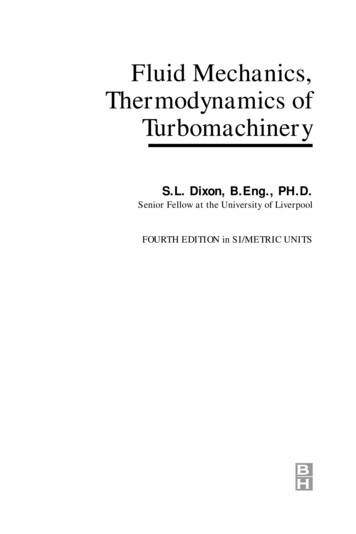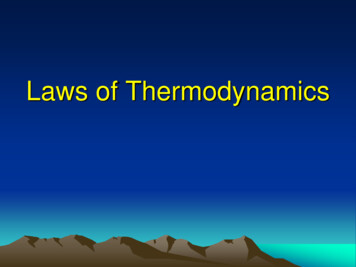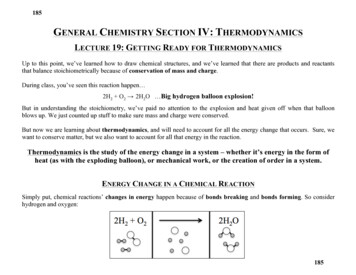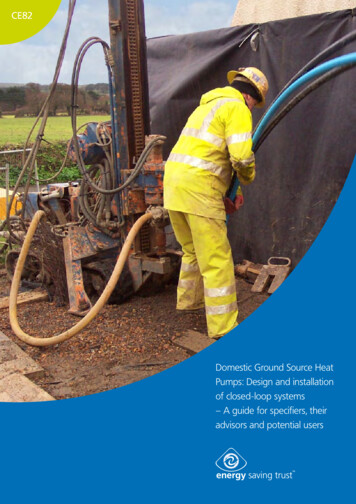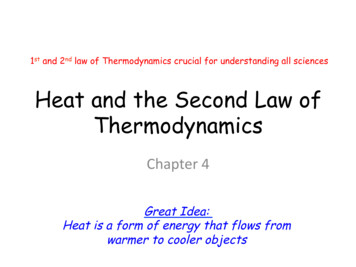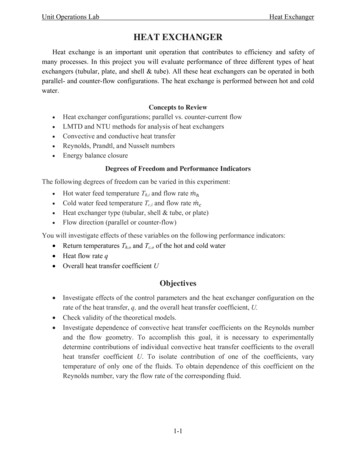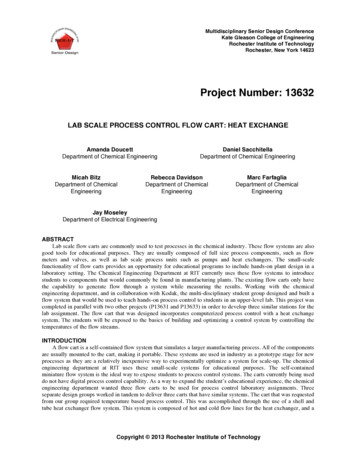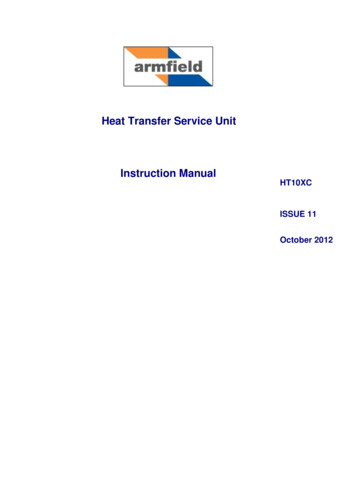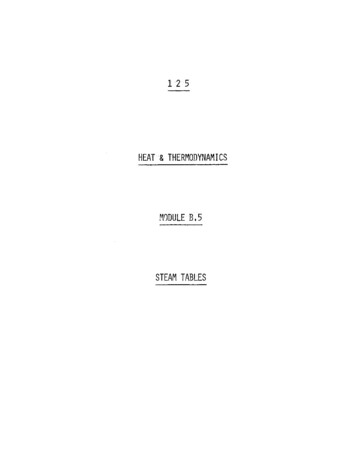
Transcription
125HEAT &THERMODYNAMICSMODULE B,5STEAM TABLES
125 - 8.5Heat & ThermodynamicsMODULE 8.5STEAM TA8LESCourse Objectives1.Given values for temperature, pressure, enthalpy and aset of steam tables, you will be able to identify thestate of water as one of the following:(a)(b)Subcooled Water.Saturated Water.(c)Wet Steam.(d)(e)Saturated Steam.Superheated Steam.2.Given the initial and final state of water and two outof three of the following parameters: pressure, temperature, enthalpy, you will be able to perform simplecalculations to determine the third quantity.3.Briefly describe the process of "steam hanuner" andexplain why it is a problem and how it may be avoided.4.Given a constant volume system with provision for addingor removing water, stated initial conditions, and one ormore final condition, you will be able to state whetherthe remaining final conditions increase, decrease, orstay constant.You will be able to explain your statement and determine the amount of any changes thatresult.Enabling Objectives1.Given changes of temperature, pressure and enthalpy, youwill be able to determine the corresponding changes involume.November 1981-1 -
125 - B.5STEAM TABLESThe steam tables provide us with a very effective meansof quantifying operating conditions.You should have a copy of steam tables as part of themodule.The units for the tables are mainly S.l.Turn topage 4 in the first set of steam tables.You will see awhole series of columns under a variety of headings.TABLE 1T.·c,,- SATURATION LINE 0311.050Spacific E nttopvSpll ;ific 425.4427.5102.5103.0103.5'04 9438.1kJ/kllTemp.Specific Volumedm 3 /k1l·c·c,,'f'f, .6 ,1.31251.31821.33505.944B'f, ,1673.01645.3The steam tables may be using a reference of pressure ortemperature depending purely upon convenience.You willrecall that in the 'Basics' module, when we were discussingtempera ture, we read that as tempera tu re increased so theforce exerted by the molecules of the fluid on the containment increased and this was in fact the increase of pressure.In a saturated system, ie, a system operating betweensaturated liquid and saturated steam, pressure and temperature are unique and interdependent, ie, if you knew the pressure of the system you could look up the saturation t mpera ture at which the system was operating.Equally, if you knewthe temperature you could look up the saturation pressure atwhich the system was operating.TemperatureThe temperature of the fluid 1S shown in the extremeleft hand column.This is in fact the saturation temperatureand as you can see, is measured in c.-2 -
125 - B.5TABLE 1 - SATURATION LINE (TEMPERATURE ISPl'Cific EntropykJ/kg "cSp'!ICifioc .1471.1671.187 01366.00205.99055.97905.96755.95605.9446Sp«:ific VOoI,,",dm)ll , 7.31377.30787.3020'f 04731672.01644.31617.21590.61564.S, The pressure upon which the steam tables is based isabsolute pressure.A slight confusion arises here becausethe pressure is measured in Ibar' which is roughly one atmosphere.TABLE 1 - SATURATION LINE (TEMPERATURE)T."p. :,.'·.A :p.s;iVli,SpecifOc EntropykJfkg "cSpecific nthalpyb.w,' ":",'l.,;"ckJ/Jcg"';i':(p 'D::3};' 100.0100.5101.0101.5102.0102.5103.0103.5104 0104.5':' .,. ,.:.":.'", ",'.":'.,'.',i. . . .". "":},: 5.9438.1h f h 'fSpecific Volume·f. .32252.96.01,36Tl!lmp.nm 3 1\cg"c, 4.0104.5'f.1466.21442.5Fortunately there is a reasonable conversion, 1 bar 100 kPa(a).So, if we know the pressure kPa(a) we can divideby 100 to get the pressure in bar. For example, if the steampressure to the turbine is 4 MPa then the pressure in bar 4 x 10 3 kPa 4 o 003 bar 40 bar.This pressure is the saturation pressure correspondingto that temperature.for example, if the turbine is beingfed with saturated steam at 200 o e, we can determine the steampressure.Keep looking down the temperature column, over thepages, until you reach t s 200 o e.In the next column thesaturation pressure is quoted as 15.549 bar.-3 -
125r .Atn.P,-. cbM 54916.893852.4856.9861.4865.9870.5B.5.S ificSp- ific erortt.p 'k,J/k,h,-E,lt.opykJ/kliiSpecific Volum. .09714.0802406334.04644.0296T.,p.dm 3 /kg,9" 4.0Similarly, if a steam generator is producing steam at10.027 bar we can determine the temperature. Still using thefirst table, we can travel down the ps column until we get to10.017 bar.The value of t s is 180.0 0 C.Try these examples,of the module.you III findtheanswers at the end8.5.1Water is heated to produce saturatedDetermine the pressure of the steam.steamat135 C.B.5.2Saturated steam at 1.985 bar has heat removed until itbecomes wet steam at 1.985 bar.Determine the temperature ofthe steam at the new condition.B.5.3The temperature in a steam generator has to be raised to,140.0 C.What is the pressure in the steam generator at thistemperature?Sensible HeatYou will recall from module 86 that when sensible heatis applied to the liqui.d state i.t causes a change of temperature.The enthalpy of tb( liquid state is determined by itstemperature primarily, le, for the majority of needs theenthalpy of subcooled water at l40 C and 50 bar is the sameas the enthalpy of saturated liqui.d at l40 C.The symbol forunits are kJ/kg.the heat in theliquidis'h f 'andtheExamplesFeedwater enters a boiler at l75 C and 6 MPa.Determinethe enthalpy of the feedwater.The pressure of 6 MPa isequal to 60 bar.Does the pressure or the temperaturedetermine the enthalpy of the liquid?Right, so look up inTable 1 until you find t s 175 C.Now read across to columnhf where hf ::: . . . k':::-/kg.
125 - 8.5T. c,,115.01750117.0178.0179.0Am.P.Sp-elfic ,'745.5749.9754.3758.7hS jfic Entr 4.52016.72775,4SP'l'Ciiic: \lolum.dm 3 /kg"c4.49584.47804.4603, .12481.1262215.42210.63205.96201.41196.98"c,,:?1 0.5-4175.0176.0,"TlIft1p, 211 15207,08202.54198.11Try these examples:8.5.436 C.Condensate leaves the condensate extractionDetermine the enthalpy of the condensate.pumpat8.5.5Feedwater is brought up to the saturation temperature inthe preheater.The steam pressure is 4 MPa(a).Determinethe enthalpy and temperature of the saturated liquid.8.5.6A steam generator operates at 4.11 MPa(a).The feedwater entering the steam generator is subcooled by 65 C, ie,65 C below t s Determine the enthalpy of the feedwater.8.5.7Heat is added to the feedwater in the feedheaters anddeaerator.If the initial temperature of the feedwater was35 C and the suction to the boiler feedpump was at 126 C,determine the amount of heat added when the feedwater hasreachedthe boiler feedpump suction. Check your answers atthe back of the module.Latent Heat of VapourizationThis is the amount of heat required to effect a completechange of state from saturated liquid to saturated vapour orfrom vapour to sa tu ra ted liquid.Al though the value oflatent heat appears under the heading of specific enthalpy it is not!If you recall, enthalpy was a heat value measuredfrom GOC.The latent heat is the amount of heat added orremoved at constant temperature.The symbol is hfg and theunits are again kJ/kg.The suffi:K 'fg' denotes transitionfrom a fluid to a gas.-5 - 1770118.0119.C
125 - 8.5ExampleFeedwater enters a boiler as saturated liquid at 140 C.Determine the amount of heat that has to be added to producesaturated steam and also the pressure of the steam.Using Table 1, find t s 140 C.If the feedwater issaturated it is already at 140 C and only the latent heat hasto be added.Look across at column hfg and hfg and the steam pressurebar.Temp.AblI,P,-."cb ,,P,h3.614589.1591.3593.4595.5597.7140.0140.5141 0141.514203.6653.7173.7703.823Specific Enth.lpykj!kgfhfghSpecific EntropykJ/kll 33,71.7442L74931.75451.75972734.32735.02735.62144 kJ/kgis the saturatlon pressure of 3.614'fg5.18945.17955.16965.15975.1499r ."cSpeeific "olum.dm !kg,g6.92846.92376.91906.91426.9095'f1.08011.080&, ,508.49501.79495.19488.69482.30Try these examples, the answers to which are at the endof the module.8.5.8Saturated steam is produced from a steam generator at apressure of 5 MPa(a).The feedwater entering the steam generator is saturated.Determine the temperature of the feedwater, thetemperature of the steam and the amount of heatwhich has to be added in the steam generator in order to produce the saturated steam.8.5.9A condenser produces cOTldensate at 32 C from saturatedDeterminesteam.There is no subcooling of the condensate.the amount of heat which must be removed from the steam inthe condenser and the condenser pressure.,,14 :1.0140.5141.0141.5142.0
125 - B.5Enthalpy of Saturated Steamthat the saturatedThis quantity issteam possesses when measured from DOC.total heat in theshown under the column labelled 'h g 'I gas I .A closer inspection will show that h g is the sum ofThisisthetotalamountofheathf and hfg.T 'c,,210.0211.0212.0213.0214.0A""" kJ/kllhP,hf,f,h;as7;1' ,1898.S 0.651'f2.4247'cdm)/lt" '"Temp. jfic VCllu Spcific EntropykJ/kg 'cSPflCihc 3,'f, 104.24102.23100.2698.34096.462It is a great benefit to be able to have some type ofschematic so that we can see where we are at this point intime and subsequently determine either where the process waspreviously or where it will be in the future.As we have already discussed, our majorarea, is the temperature enthalpy diagram.aidlemperature. c'.-- --- - ---------- dF hl:::::: :::I:::::Ih:;:. h,!L9Entholpy, J/k gFig. 5.1- 7 -inthis,,110.0211.0212.0213.0214.0
125 - 8.5The steam tables arecalculate some values fromusing steam tables is thatthe process before you canenthalpydiagramprovidesexcellent if all we need to do isgiven data.The only problem withyou must know what is happening inuse the tables.The temperature/avisualizationoftheprocesswhich may help us to understand when and how we may use thesteam tables.Before we look at any examples,the aspects of the steam tables.let I scons ider some of1.What happens to the saturation temperature as the pressure increases?2.What happens to the enthalpy of the saturated liquid asthe pressure increases?3.What happens to the latent heat as pressure increases?4.What happens to the enthalpy of saturated steam as pressure increases?Have a look at the steam tables beforeyou read any further, and see if you can fully answerthese four questions.TemperatureAs the pressure increases, so the saturation temperatureincreases until it reaches a temperature of 374.1S o C at apressure of 221.2 bar.At this pressure some major changesoccur as we will see in a minute.Saturated LiquidThe enthalpy of the saturated liquid rises with pressureup to a maximum value at this pressure of 221.2 bar.Latent HeatThe value of latent heat falls as the pressure rises.At the pressure of 221.2 bar the value of latent heat iszero.The significance of this fact is that there is now nogradual transition while steam is being generated.As soonas the 1 iquid has reached the sa tura tion tempera tu re, anyfurther addition of heat will cause a total change of liquidto vapour.The pressure of 221.2 bar is called the criticalpressure.This is not an area with which we have any continuing concern but explains why hfg goes to zero at thispressure.- R -
125 - 8.5Enthalpy of Saturated StearnAs the pressure increases, the enthalpy of the saturatedstearn increases.However, a closer inspection will revealthat the value of the enthalpy of saturated steam reaches amaximum of 2802.3 kJ/kg at a saturation pressure around 32bar.The enthalpy then falls to a value of 2107.4 kJ/kg atthe critical pressure.If we plotted the temperature enthalpy lines for all therange of pressures we would produce a curve as shown below,produced by joining all the saturated liquid points and allthe saturated steam points.Crit;(ol Point\SuperheOl Steam100.0 barTemperatureWei Steam Csot"ot,)ZSatu'atedSteomLiquid10.0 bar----"""--"-"'-------f1.013 bar/-o-tatentHeot---------------fEnthalpy. kJ/ kgF;g. 5.2-9 -
125 - 8.5On this diagram we can see the saturation temperatureincreasing, and the latent heat reducing as the criticalpressure is approached.Let's consider an example to make this more meaningful.Feedwater enters a steam generator at 175 C.The steamgenerator produces saturated steam at 4 MPa(a).Determinehow much heat must be added to change the feedwater intosaturated vapour.Before we consider using the steam tables, we must examine the process.We know that the steam is saturated at4 MPa(a), which translates to 40 bar.At 40 bar the saturation temperature is a little over 250 C.The feedwater issubcooled when it enters the steam generator.Drawing thetemperature enthalpy diagram we produce the following:Temperature, c250 - - 175- --r-------------{,--- AIIIho-,so-"-----'--------------'-----IEnthalpy. J/kgFig. 5.3The process starting point is A where thethe liquid is hf @ 175 C (hf175). The completionB where the enthalpy of the saturated steam is(h g 250) enthalpy ofpoint is ath g at 250 C
125 - B.5The amount of heat to be added in the steam generator isthe difference between points Band A.Thus heat to be added h g 250 - hf17SoUsing steam tables,h9250 2800.4 kJjkghf175 741.1 kJ/kg.Thus Q 2800.4 - 2059.3 kJ/kg.741.1Before you try some examples, just examine Table 2 ofthe steam tables.They are based on exactly the same layoutas Table 1, except that they use even increments of pressureas the basis instead of temperature. If the temperature isquoted in whole degreesuse Table 1, if the pressure isquoted in whole numbers use Table 2.Try these examples, the answers to which are at the endof the module.I would suggest you draw a partial temperature/enthalpy curve to illustrate the condition.B.5.10Saturated water at 30 bar is cooled to a temperaturethat is lOBoC below the saturation temperature.How muchheat has been removed?B.5.11A steam generator produces saturated steam at IB6 C.The feedwater, at the suction to the boiler feedpump, whichpumps the feedwater directly into the steam generator, isliquid at 4.4 bar and is subcooled by 20 C.How muCh heathas to be supplied to produce 1 kg of stearn?B.5.12An oil cooler has cooling water entering at 17 C andleaving at 41oC.Determine the increase in the enthalpy ofthe water.- 11 -
125 - B.5B.5.13A condenser at 5 kPa (a) receives saturated steam.Thecondensate is subcooled by SoC.Determine how much heat isrejected to the condenser per kg of steam.Enthalpy of Wet SteamYou may recall from the 'Basics' Module 86 that we coulddescribe 'wet steam' as steam which had not received all itslatent heat of vapourization.This is a little contradictoryand it would be more accurate to describe wet steam as a mixture of water droplets and vapour, both at the saturationtempera ture.Only the vapour has received its latent heat of vapourization.How much latent heat will the wet steam receive?That depends upon the proportion of vapour in the mixture.If 70% of the mixture by weight is vapour, then 70% of thelatent heat has been added and a further 30% has to be addedbefore the droplets have all been converted into vapour andwe have saturated steam.Determining the enthalpy of wetsteam requires one more step in the calculation than previously.In practice, we often use names and terminology whichmakes understanding unnecessarily complicated.For example,we talk about Iwet steam' but when we perform calculationsusing 'wet steam' it is more usual to think about how 'drylit is and not how wet.Dryness FractionThe dryness fraction is a ratio, by weight, of theamount of vapour in a mixture to the total weight of liquidplus vapour.q weight of vapour x 100weight of vapour weight of liquidIf the dryness fraction is 80% then 80% of the mixtureis saturated vapour and equally 80% of the latent heat musthave been added.Equally, 20% of the mixture is saturatedliquid.-1/ -
125 - 8.5Let's look again at the temperature enthalpy diagram tosee how we determine the enthalpy of the wet steam.Temperature,DCBO'\,-AIIIIIIEnthalpy, J/kgFig, 5.4Suppose point B represents wet steam having a dryness of80%.At point A the enthalpy is hf of the liquid.At apoint 80% along the line AC we will have added 80% of hfq.Consequently, the enthalpy of the 80% dry steam will Behf 0.8 hfg'Consider this example:at 40 bar.the steam.q A steam generator produces steamThe steam is 15% wet.Determine the enthalpy ofIf the steam is 15% wet it must also be 85% dry -thus0.85.Using Table 2 hf at 40 bar 1087.4 kJ/kg& hfg 1712.9 kJ/kg.Thus enthalpy of steamDo these exercises.module. 1087.4 0.85 x 1712.9 kJ/kg 1087.4 1456 kJ/kg 2543.4 kJ/kg.The answers are at the end of- 13 -the
125 - B.5B.5.14A low pressure turbine exhausts steam at 12% moistureand at a pressure of 6 kPa(a).Determine the enthalpy of thesteam.B.5.154 kg of liquid are removed from a moisture separator.If the steam was 88% dry, what was the mass of wet steamentering the moisture separator? Assume that the steam leaving the moisture separator is saturated.B.5.16A steam generator produces wet steam of 92% dryness at196 C.The feedwater enters the steam generator at 134 C.Determine how much energy is added to the feedwater in thesteam generator.B.5.17A process heater produces saturated steam at 30QoC fromsteam at 18 bar.Determine how much heat has beenadded to the steam.18% wetB.5.18A condenser receives 12% wet steam at 35 C.The condensate is subcooled by 5 C.Determine how much heat has beenremoved in the condenser.B.5.19Feedwater enters a steam generator at 160 C and is converted into steam having a saturation temperature of 220 C.The heat supplied by the stearn generator is 1900 kJ per kilogram of stearn.Determine the dryness fraction of the steam.Superheated StearnIn module B.6 on 'Basics', we define superheated steamas steam which exists at a temperature above the saturationtemperature.Steam Tables 1 & 2 only deal with saturatedconditions; so another set of tables is required for superhea ted steam.-14 -
125 - is information is presented using a base of pressure whichis in bar as previously and is the first quantity across thetop of the page.TA8l-E J -PROPERTIES OF WATER AND STEAM"i.1; ,'I o. i,,,,L',," t."". Vo.', "I. '." IU30270.7,1 14'"\2769'.,50· .7; 0').4"'00120.'1.01Z1. 1 ."1012 so3174J2l1)Oij''-In"cO, ;000.'",000"50,i :'(14""""""8.;0'J'S1!' l,1' 0HJ4a.Oe.'8,1Jl1'C"00 ,;" " ','3'"1;13.,, ,,13'';I!'0"'""'3 'j,,.,'2&,9912dM'%8JO'O,171J21S;JllO]"'".;l; .JI );l0.70J'.30'.-, 1.074v.GG,,6"")1. 121.011l,O'.;;33.'1. ,,,6 " 81;;D.590'"' ,,"n410.)1414'9",.UiL B.',"UO2' ""2n5·'S.'270014]3'5 916"5"d'. -.ISH U78G.8!l41.0'",462. 1.011:109,71.('.44'0.7 ,,. '7'.'9A6J2.2285S .1,:lIlO3110327'1,6'0J .89:l- ".;)8'"g;o .I,W,"""M :1123J17- .8.1928.3218.456". .59S.211 J.g172.'dM.2"",, ,, ,1 74.40.70Jl.or.1,;;076,g29""'M'1.093 1·: 7ooro1. 8S, "27 3,., . T,J07, \ A"'-'!II632.2,'1.195, ,:J ".a.c.oo3'02.m" 1.8427.0597 2121.%18n un 25.u H4sna57i}. I611.2.""".1",15'.4 ,a O.4,.,. .,0.'SB,t.1.16Gf.B192? 2.,ltJ,.,'.9J'5. :l.0.'D33'5.51,012'6\,4 it?'v .,-6.1Q50n 'cJ' C4 I.M21,0'l'ti.OO:i1. ' J 2,07. 144J4,4JOW"",m10.2,, ,. ' 97.""05TJ. 591.i6: 1 " ", ro,. "9,5.m'-: l;'.a., 1.10 '. , '.00.- . "" (;61" J1""""591,m'""S ':)8ll.;,;a8.:l9239:i.JS .8, , ti. 1.101HIS1,0:)';'.S,; ,. ,, 38,1Consider the column under the pressure heading of 4.0(bar).The next line lists the saturation temperature forthat pressure, ie, at 4.0 (bar) the t s is 143.6 C.The nexttViO lines contain three headings and Vie are only interestedin the enthalpy column headed Ih I .The enthalpy of thesaturated liquid and vapour is shown.In our illustration at4.0 (bar) h f 604.7 kJ/kg and hg 2738 kJ/kg.All this information is readily available from Tables 1and 2.Now we have the difference.We have already seenthat the saturation temperature at 4.0 (bar) is 143.6 C.Suppose we have s team at 4.0 bar and at a tempera tu re of300 C.How do Vie determine the enthalpy?At the extremeleft hand of the sheet is a temperature column.Look dOVinthe column to the temperature of 300 C, then read across tothe entry in the column 'hI at 4.0 (bar) when the enthalpymay be seen to be 3067 kJ/kg.ExampleSaturated steam at 10 bar from a moisture separator isheated to 230 C in a reheater.Determine a) the enthalpy ofthe steam leaving the reheater,b) the heat added in the reheater.15 -,,1,30.7,-.3.1')1\B.J:1O,. '3' ."3., ", 1:.COl.
125 - B.5Again we can use theillustrate the e, c230-- -r-"'O"-'b"o'-,.1,AEnthalpy, J/kgfig. 5.5The initial condition is at point A where the steam issaturated at 10 bar.The enthalpy may be determined fromTable 2, hg 2776 kJ/kg.The final condition is superheated steam at a temperature of 230 C and a pressure of 10 bar.Using Table 3 wehave to take two readings because the temperature scale inTable 3 only progresses in steps of 50 C.At 10 bar and 20DoC h 2827 kJ/kg, andat 10 bar and 250 C h 2943 kJ/kg.The difference for SO C is 2943 -2827 116 kJ/kg.At 230 C the enthalpy will be enthalpy at 200 C 30/50of the difference 116.Thus ha) 2827 3/5 x 116 2896.6 kJ/kg.The enthalpy differenceadded in the reheater.Finalreheater.b)enthalpy -2896.6 -2776 initialrepresentsenthalpy120.6 kJ/kg.-16 -the amountheataddedofinheatthe
125 - 8.5Do these examples,module.theanswersareattheend ofthe8.5.20Determine the enthalpy of steam at 20 bar and a temperature of 375 C.8.5.21380 kJ of heat are added to 1 kg of 15% wet steam atbar.8Determine the temperature of the final steam.* * * * *Before we proceed, with the course material, do the following exercises in preparation for the criterion test.8.5.22Given the following information,identify the states ofwater as:orsubcooled liquidsaturated liquidwet steamsaturated stearnsuperheated steam.EnthalpyTemperaturePressurea)561.4 kJ/kgb)2323 kJ/kge)2855 kJ/kgd)2538.2 kJ/kg20 C0.02337 bare)125.7 kJ/kg30 C0.07375 barl33.5 C32.9 CZOQoC3.0 bar0.05 bar5.0 bar8.5. 23Feedwater enters a steam generator at laDaC and is converted into steam with 4% moisture at 260 C.How much heatis added in the steam generator per kg of steam?- 17 -
125 - B.5B.5.24Steam which is 12% wet ente'rs a condenser at 36 C.Thecondensate is subcooled by 3 e.Determine how much heat isrejected to the condenser per kg of steam.Volume of Liquid and VapourAs discussed in the 'Basics' module, one of the effectsof changing temperature on a fluid is the change of volume.This applies to both liquids and vapours.In the specificprocess of adding the latent heat of vapourization the changein volume is phenomenal.The steam tables will allow thevolumes to be calculated without any difficulty.Looking at Table 1 of the steam tables, the last columngroup is headed "Specific Volume".Specific volume is volumeper unit mass.In the 5.1. system there are two acceptablevolume measurements:a)the cubic meterb)the liter, wh ich is one1Im31t, .The steam tablesdecimeter - dm 3 usethethousand th of aliter whichcubic meter -theycallisfoundthecubicVolume of LiquidThe volume of liquid per kilogramcolumn headed vf - volume of fluid.undertheExampleDetermine the volume of 30 kg of water at 55 C.Looking at Table 1, at temperature t s 55 C, select thevalue of vf 1.0145 /kg.Thus 30 kg will occupy 30 x1.0145, 30.435' 'DO these examples and check your answers at the end ofthe module.B.5.25holds 3 m3 of waterwater are in the tank?A tank- 18 -at90 C.How manykgof
125 - 8.58.5.26Condensate at 36 C is heated to 175 C in the feedheatlngsystem.Determine the percentage increase in volume ot thefeedwater.Volume of Saturated SteamThere is a large increase in the volume of working fluidas the transition from liquid to vapour occurs.This isparticularly true of vapour at low pressures.The volume ofsaturated steam is shown in the steam tables, still lookingat Table 1, under column vgoExampleSaturated steam at Boac is condensed to saturatedliquid. Determine the reduction of volume which occurs.Using Table 1, v g at 1.0292 llkg.Boac 3409.1 i/kg, ers to just over 1 liter.Do these examples and check your answers atthe module.the end of8.5.27Feedwater enters the steam generator at l75 C.Thesteam leaving the steam generator is saturated steam at250 C.Determine the volume increase that occurs within thesteam generator.B. 5.28Saturated steam at 40 C is condensed to subcooled liquidat 35 C.Determine the volume reduction.Volume of Wet SteamThe volume of wet steam is treated in exactly the sameway as we treated the enthalpy of wet steam.The volume ofthe wet steam is equal to the volume of the liquid plus thedryness fraction multiplied by the change in specific VOlumewhen going from liquid to vapour]ie, v vf qVfg.-19 -
125 - 6.5ExampleDetermine the volume of steam at 12% moisture and 165 C.From Table 1, vf 1.1082 l!kg and Vfg 271.29 l!kg.v ;:: vf qVfg 1.1082 0.88 x 271.29 239.8 i/kg.Do these problems andthe module.check your answers at the end of6.5.29Saturated steam at 250 C enters the hp turbine and steamwith 12% moisture leaves the low pressure turbine at a pressure of 5 kPa(a).Compare the initial steam volume per kgwith the final volume.6.5.30The low pressure steam in question B.S. 29 is condensedto condensate which is 5ubcooled by 3 e.Determine thevolume reduction which occurs in the condenser.steam HammerThis process should not be confused with "water hammer"which is the result of rapidly accelerating or deceleratingthe flowrate of fluids and is usually more of a problem inliquids.Steam hammer is associated with hot pressurized watersystems.Steam hammer is the result of continuous rapidvapour production and continuous recondensation within thesystem.The problem occurs in lines which have large amounts ofpressurized hot liquid that is reasonably close to the saturation temperature.Imagine you have a line full of hot waterat 160 C at a pressure of I MPa(a).The saturation temperature corresponding to I MPa(a) is 180 C which means that theliquid in the line is subcooled and there can be no vapourpresent.on
125 - B.5Suppose there is no flow and we have to commission thecircuit by opening the downstream valve. What will happen tothe pressure in the line upstream when the valve is opened?It will fall!If the pressure falls to the saturation pressure corresponding to 160 C, ie, 618 KPa(a) vapour will beproduced in the line.The effect of producing vapour creates a momentary pres-sure increase which results in some of the vapour recondens109.occupyAs the vapour condenses, liquid moves in rapidly tothe low pressure volume previously occupied by thevapour and produces a shock or hammering of the line.The liquid shuttles to and fro in the line with violentreaction which can result in severe damage to pipework andvalves.In this overall process the pressure is unstable andfluctuating rapidly, causing pockets of vapour to be producedat the same time causing other pockets of vapour to condense.The solution to this problem is to prevent the pressurefalling down to the saturation value.The problem is mostlikely to be encountered when warming up a line where heavycondensation may have resulted in a large volume of liquid.Open the valves very slowly and if steam hammer is experienced, you know that the pressure in the line is too low and theflowrate should be reduced to raise the line pressure untilthe line is free of liquid.* * * * *B.5.31Briefly describe the process of "steam h
STEAM TA8LES Course Objectives 1. Given values for temperature, pressure, set of steam tables, you will be able state of water as one of the following: (a) Subcooled Water. (b) Saturated Water. (c) Wet Steam. (d) Saturated Steam. (e) Superheated Steam. enthalpy and a to identify the
